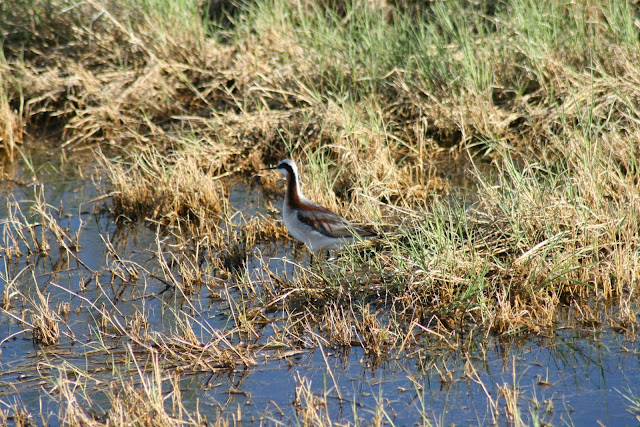It's been over a month since I have been able to do some serious birding. I wanted to get out to Antelope Island before the Phalaropes had all moved on so that is where I went today and what a wonderful day it was. 40 species in all and some nice bonuses, including a new life bird Northern Waterthrush, unfortunately I was not able to get a picture of the Waterthrush. Here is my list and then I will list some pictures:
American Goldfinch, Chipping Sparrow, Yellow-headed Blackbird, American Avocet, Black-necked Stilt, Wilson's Phalarope, Red-necked Phalarope, Western Sandpiper, Killdeer, Long-billed Curlew, Barn Swallow, Tree Swallow, Sage Thrasher, California Gull, Ring-billed Gull, Franklin's Gull, Eared Grebe, Bufflehead, Sharp-shinned Hawk, Chukar, Song Sparrow, Black-billed Magpie, Burrowing Owl, Spotted Sandpiper, Horned Lark, Wilson's Warbler, Nashville Warbler, MacGillivary's Warbler, Western Tanager, Virginia Rail, Orange-crowned Warbler, Warbling Vireo, Northern Waterthrush, American Robin, Willow Flycatcher, Lark Sparrow, California Quail, Lesser Goldfinch, Rufous Hummingbird, Black-chinned Hummingbird.
American Goldfinch

American Avocets and Black-necked Stilts

Western Sandpipers

Wilson's Phalaropes

Red-necked Phalaropes

American Avocet, Wilson's Phalaropes, Western Sandpipers

Wilson's Phalarope, Western Sandpipers

Killdeer, Black-necked Stilt, American Avocet

Spotted Sandpiper


Long-billed Curlew


Franklin's Gull

California Gull feasting on Brine Flies

Beautiful Morning at Antelope Island

Eared Grebes

Logger-head Shrike

Barn Swallow

Sage Thrasher


California Gull was posing with several species including these Franklin's Gulls

California Gull with Black-necked Stilt

California Gull with Long-billed Curlew

Curlew and Gull Feeding on Brine Flies

Chukars


Burrowing Owl

Antelope Island Flora

Nashville Warbler

Rufous Hummingbird

Chipping Sparrow

Here are the bonus pictures
Skunk

Marmot
Pronghorn

Mule Deer

Bison


















































